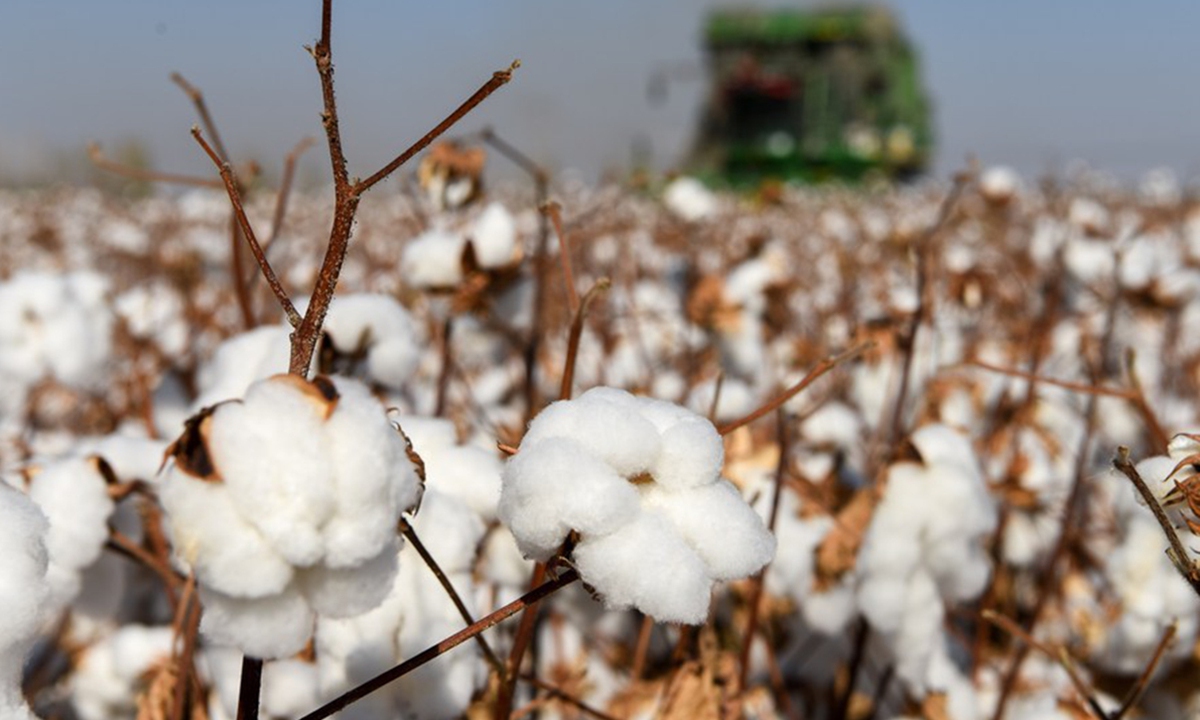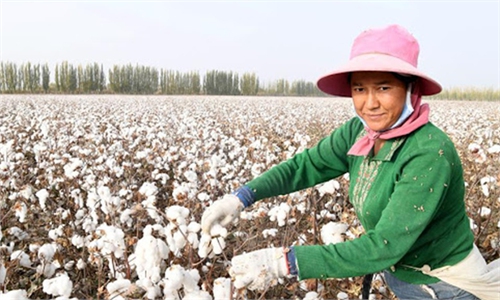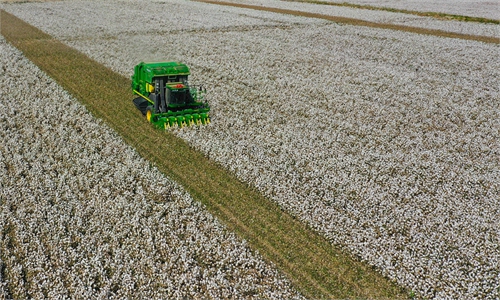China scales up cotton imports amid global price rally, not a result of US ban
Move driven by commercial requirement, not a result of US ban

Modern agriculture gaining ground in Xinjiang's cotton fields. Photo: VCG
China has been importing bulk amounts of cotton from countries including the US, India, and Brazil in recent months amid a global price rally which sent the crop's price to a decade-high, the Global Times learned.
But the jumps in imports has mainly been driven by either the desire of Chinese agencies to stockpile goods for profitable gains or to fulfill commercial requirements on the cotton's texture, rather than what some Western media have boasted as due to foreign companies' ban on the use of Xinjiang cotton, which they say have "forced" Chinese textile makers to import cotton from elsewhere and sell it back to foreign markets.
The cotton in Northwest China's Xinjiang Uygur Autonomous Region - the main cotton production region in China - entered a large-scale centralized harvesting period in early October, with orders swarming in and cotton being collected at a record offering, industry insiders said. In addition, some upstream companies are taking a "wait-and-see" attitude amid price hikes, further fueling a shortage of supply in the domestic market.
"Chinese downstream industries have been desperately securing cotton from everywhere, but the biggest issue is that global cotton dealers are not willing to sell at the current moment, anticipating a further price flare-up. Logistical barriers are another problem," a manager of a cotton import agency based in North China's Tianjin Municipality surnamed Chen told the Global Times on Friday. He also took note of an increase in cotton imports from the US, India, Brazil, and Africa in recent months.
Since August 1, the pace of US exports of cotton to China has been 83 percent faster than that of last year, according to the US Department of Agriculture.
A Wall Street Journal report attributed the uptick in sales to a ban imposed by the former Trump administration on Xinjiang cotton over alleged "force labor" in the region, claiming that Chinese clothing firms are importing a lot more cotton to fill up the void of Xinjiang cotton before reshipping abroad, so that their overseas orders are not affected by the ban.
Rebutting such claims, industry insiders noted that political factors only play a marginal role, and instead the rise in imports is a business choice out of product texture and quality.
"Due to climate-related factors, seeds and techniques, some cotton from Xinjiang contains more foreign fibers than that of the US and Brazil. This means for certain knitting yarn used for bleaching purposes, Chinese factories have to use cotton from the two production areas," Chen explained.
He added that some US companies would also designate the source of cotton used in clothes and shoes when placing orders with Chinese manufactures. "Some prefer cotton from Egypt, which has long been known for its high quality, and would explicitly highlight this point in their marketing to appeal to consumers," Chen noted.
On the other hand, cotton farmers in Xinjiang are embracing one of the most robust sales seasons recorded, despite boycotts from Western clothing brands such as H&M, Nike and Adidas earlier this year.
"We have been collecting cotton from local farmers at a price that is in tandem with the recent rally, but we have no yet started to sell them," Yi Jing, the vice general manager of Xinjiang Siwei Textile Technology, told the Global Times on Friday. While holiday breaks and electricity shortages contributed to the phenomenon, Yi admitted that the company, as well as other peers in Xinjiang, is adopting a "wait-and-see" approach to maximize profits.
The Global Times learned from industry insiders that Chinese consumers have been embarking on a shopping spree of Xinjiang cotton products in the past months, boosted by patriotic sentiment and increasing endorsement on quality.
A recent report released by the China Cotton Association estimated that the cotton output in Xinjiang is expected to to reach 5.3279 million tons in 2021, up 1.6 percent from last year.
On Friday, the most active cotton contract for January 2022 delivery opened higher than the daily 10 percent on the Zhengzhou Commodity Exchange (ZCE).


